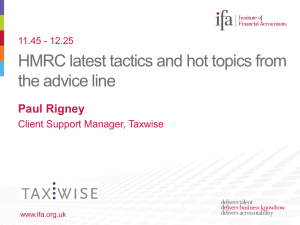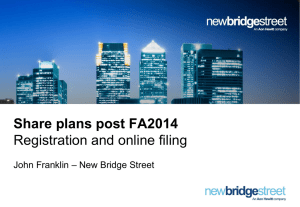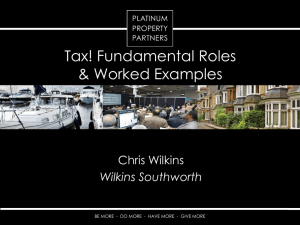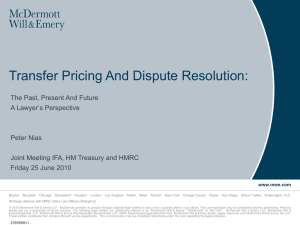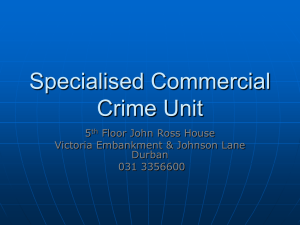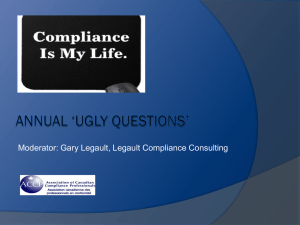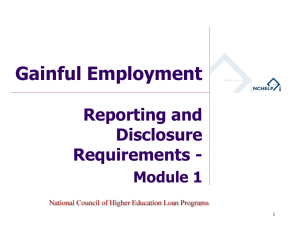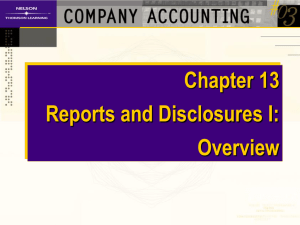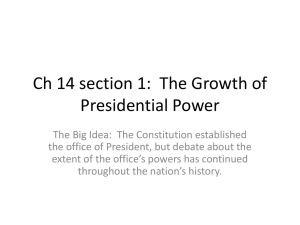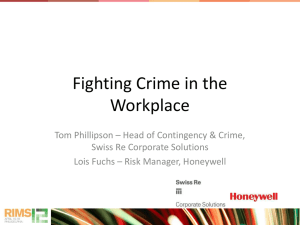Birmingham-AAT-9-5-12
advertisement
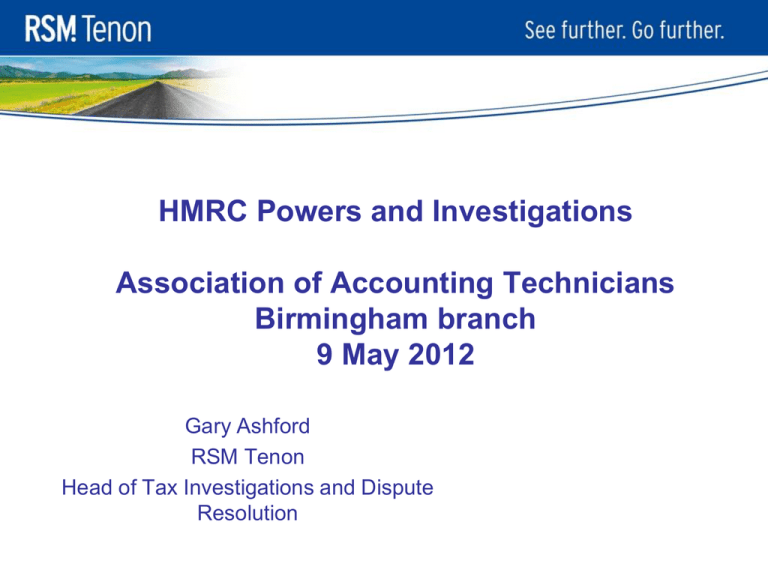
HMRC Powers and Investigations Association of Accounting Technicians Birmingham branch 9 May 2012 Gary Ashford RSM Tenon Head of Tax Investigations and Dispute Resolution Agenda Update on tax administration/powers and penalties Latest trends in HMRC activity Changes to Code of Practice 9 Liechtenstein/UK agreement Swiss/uk agreement Tax Gap 2008 £40b 2009 £35b Plans to reduce by £7b pa! Non Payment 8% Hidden Economy 8% Error 8% Avoidance 17% Criminal Attacks 13% Failure to take reasonable care 15% Evasion 17% Legal Interpretation 14% Source- HMRC Protecting Tax Revenues 2009 HMRC’s Powers HMRC Powers Upgraded – – – – – Penalties Information and inspection powers Assessing time limits Publishing Names of Deliberate Defaulters Records? Penalties for inaccuracies HMRC’s Penalty Regime – s97 Sch 24, FA 2007, inaccuracies 100% max 70% max 50% prompted 30% max 15% prompted 35% prompted 30% min 20% min 0% min Mistake despite reasonable care Failure to take reasonable care Deliberate understatement Deliberate understatement and concealment HMRC’s Penalty Regime – Sch 24, FA 2007, offshore penalties, category 2 Offshore Income – s35 and Sch 10 FA 2010, amends Sch 24 FA 2007 150% max 105% max 75% prompted 45% max 22.5% prompted 52.5% prompted 45% min 30% min 0% min Mistake despite reasonable care Failure to take reasonable care Deliberate understatement Deliberate understatement and concealment HMRC’s Penalty Regime – Sch 24, FA 2007, offshore penalties, category 3 Offshore Income – s35 and Sch 10 FA 2010, amends Sch 24 FA 2007 200% max 140% max 100% prompted 60% max 30% prompted 70% prompted 60% min 40% min 0% min Mistake despite reasonable care Failure to take reasonable care Deliberate understatement Deliberate understatement and concealment HMRC Information and inspection powers Criminal Information powers (PACE 1984) Civil Powers – s113/114 and Schedule 36 FA 2008 – s86 and Schedule 23 FA 2011- Data gathering powers (from 1 April 2012) HMRC’s Information & Inspection Powers, s113, 114 & Schedule 36 FA 2008 Taxpayer notice (Para 1): requires a person to provide information or produce documents reasonably required for the purpose of checking their tax position Third party notice (Para 2): another person’s tax position Unnamed third party (Para 5) – “Tax position” (Para 64): person’s position as regards any tax includes: past, present and future liabilities – “Tax” (Para 63) is IT, CGT, CT, VAT and relevant foreign tax HMRC’s Information & Inspection Powers, Schedule 36 FA 2008 Right of appeal unless – Pre approved by tax tribunal, or – Statutory records (records required to keep by the Taxes Acts) – Onerous (if unnamed third party) HMRC’s Information & Inspection Powers, Schedule 36 FA 2008 Safeguards – Request must be reasonable and proportionate – Must be in person’s possession or power – Documents subject to appeal process – Journalistic material – Personal records – Documents over 6 years old at date of notice – Documents over 4 years before deceased person’s death – Privilege/Auditors/Advisers papers HMRC’s Data Gathering Powers Data gathering powers (1 April 2012) Relevant data holder Relevant data Cannot be used to check tax position of data holder Replaces many of the old information gathering powers; s16, 17, 18 etc HMRC’s Civil Inspection Powers “An officer…may enter business premises and inspect: the premises business assets on those premises business documents on those premises If the inspection is reasonably required for the purpose of checking that person’s tax position” Paragraph 10, Schedule 36, FA 2008 HMRC’s Civil Inspection Powers Inspection powers by prior agreement 7 days notice announced or unannounced approvals – authorised officer & First Tier Tribunal HMRC’s Inspection Powers Inspection powers – restrictions & defences that person enter premises – not force entry inspect only – not search or interview Inspect vs search: “you are walking along a corridor with a representative of the business and come to a door in the corridor. He goes through it but the door slips and closes in front of you. You may touch the door to open it and continue” “You are shown into a room in which the books, records and invoices you asked for have been placed on a table for your inspection. You are allowed to open the files and boxes of records that have been collected. You are allowed to walk around and look at the pictures on the wall. You are not allowed to open the filing cabinet in the corner just to see what is in it” CH25160 HMRC’s Information and civil inspection Powers Penalties for non compliance – £300 – £60 per day – Scope to link to tax in special circumstances Assessing time limits, s118 & Sch 39 FA 2008 amends TMA 1970 General – Routine self assessment • 4 years from the end of year of assessment (S34, amended by Sch 39) – Person’s self assessment to displace HMRC determination • Later of 3 years from filing date and 12 months from date of determination (S28c (5) TMA 1970, amended by Sch 39) – HMRC determination where notice to make a return but no return delivered • 3 years from filing date (S28 (5) TMA 1970, amended by Sch 39) Assessing time limits Discovery – Not careless • 4 years from the end of the year of assessment, (S34 TMA 1970, amended by Sch 39) – Careless • 6 years from the end of the year of assessment, (S36 (1) TMA 1970, amended by Sch 39) Assessing time limits Deliberate, • 20 years from the end of the year of assessment, (S36 (1A) TMA 1970, amended by Sch 39) Assessing time limits Failure to notify – Reasonable excuse • 4 years from the end of the year of assessment – No reasonable excuse or unreasonable delay • 20 years from the end of the year of assessment (for 2008/9 and earlier tax must be attributable to fraud or neglect) Assessing time limits Claims and elections – IT/CGT- s42 TMA 1970 – CTSA - Part VII Schedule 18 FA 1998 (part VIII Group relief, part IX Capital allowances) Assessing time limits Claims and elections General – The general rule, as set out in s43(1) is that a claim must be made within 4 years from the end of the year of assessment to which it relates. – For example, a claim for 2008-09 must be made by 5 April 2013. – Where a person makes a claim for a year of assessment in respect of which they have not been given a notice under TMA 1970 Section 8 (personal return), TMA 1970 Section 8A, (trustee’s return), TMA 1970 Section 12AA (partnership return) – Within 1 year of the end of the year of assessment, the time limit for making the claim is 5 years from the 31 January next following the year of assessment. From 1 April 2012 this time limit will change to 4 years from the end of the year of assessment. But the Taxes Acts may prescribe a longer or shorter period in respect of certain claims and if that is so, that time limit overrides the general rule of s43(1). Assessing time limits Late Claims and elections – Overpayment relief • 4 years of the end of the tax year • Transitional rules for 2004/5 and 2005/6 if claim relates to SA return and notice to make return was given more than 12 months after end of tax year (then 31 January 2011 and 31 January 2012) • Amount assessed which should not have been • Amount paid which was not due Assessing time limits Extended Time limits- Consequential Claims Where HMRC issue a discovery assessment or amend SA return in closure notice scope to make late claims (limited to the extent of the discovery assessment or amendment) Non Culpable (Claims and elections) s42/43 TMA 1970 (Para 61- 64 Schedule 18 FA 1998) - Can make claim or election within 12 months from end of year of assessment in which assessment or amendment made Culpable - Can make claim within 12 months from end of year of assessment in which assessment or amendment made s36 TMA 1970 Publishing Names of Deliberate Defaulters s94 FA 2009 Cases settled on or after 1st April 2010 (2011 Tax return) Must be: If disclose – exempted tax lost £25,000 or more “deliberate” and “deliberate and concealed” cases failed to disclose during compliance check Did not obtain full reduction for quality of disclosure Latest trends Latest trends Offshore Coordination Unit Tax Evasion Taskforces COP9 Changes to Code of Practice 9 Contractual Disclosure Facility Background to Contractual Disclosure Facility Code of Practice 9 (cases of suspected serious fraud) Pre Gill & Gill PACE Civil Investigation of Fraud Contractual Disclosure Facility HMRC’s Criminal Investigation Policy “HMRC's aim is to secure the highest level of compliance with the law and regulations governing direct and indirect taxes and other regimes for which they are responsible. Criminal investigation, with a view to prosecution by the Revenue and Customs Prosecutions Office (RCPO) in England and Wales – or the appropriate prosecuting authority in Scotland and Northern Ireland, is an important part of HMRC's overall enforcement strategy. It is HMRC's policy to deal with fraud by use of the cost effective Civil Investigation of Fraud (CIF) procedures, wherever appropriate. Criminal Investigation will be reserved for cases where HMRC needs to send a strong deterrent message or where the conduct involved is such that only a criminal sanction is appropriate. However, HMRC reserves complete discretion to conduct a criminal investigation in any case and to carry out these investigations across a range of offences and in all the areas for which the Commissioners of HMRC have responsibility. Continued HMRC Policy on Tax Fraud Continued Examples of the kind of circumstances in which HMRC will generally consider commencing a criminal, rather than civil investigations are: – In cases of organised criminal gangs attacking the tax system or systematic frauds where losses represents a serious threat to the tax base, including conspiracy; – Where an individual holds a position of trust or responsibility; – Where materially false statements are made or materially false documents are provided in the course of a civil investigation; – Where, pursuing an avoidance scheme, reliance is placed on a false or altered document or such reliance or material facts are misrepresented to enhance the credibility of a scheme; – Where deliberate concealment, deception, conspiracy or corruption is suspected; – In cases involving the use of false or forged documents; – In cases involving importation or exportation breaching prohibitions and restrictions; Continued HMRC Policy on Tax Fraud Continued – – – – – – – – – – In cases involving money laundering with particular focus on advisors, accountants, solicitors and others acting in a ‘professional’ capacity who provide the means to put tainted money out of reach of law enforcement; Where the perpetrator has committed previous offences / there is a repeated course of unlawful conduct or previous civil action; In cases involving theft, or the misuse or unlawful destruction of HMRC documents; Where there is evidence of assault on, threats to, or the impersonation of HMRC officials; Where there is a link to suspected wider criminality, whether domestic or international, involving offences not under the administration of HMRC. When considering whether a case should be investigated under the Civil Investigation of Fraud procedures or is the subject of a criminal investigation, one factor will be whether the taxpayer(s) has made a complete and unprompted disclosure of the offences committed. However, there are certain fiscal offences where HMRC will not usually adopt the Civil Investigation of Fraud approach. Examples of these are: VAT Missing Trader Intra-Community (MTIC) Fraud Vat 'Bogus' registration repayment fraud Organised Tax Credit fraud” Contractual Disclosure Facility (CDF) New approach from 31 January 2012 Contractual Disclosure Facility (CDF) HMRC’s undertaking – In exchange for taxpayer’s undertaking, HMRC agrees not to pursue a criminal investigation into the tax frauds the taxpayer discloses Taxpayer’s undertaking – Undertakes to make a full disclosure of all tax irregularities under the terms of the CDF. • 1st stage – a valid outline disclosure of the tax frauds within 60 days! • 2nd stage – a statement certifying a full complete and accurate disclosure of all tax irregularities has been made together with – Certified statements of Assets & Liabilities, Bank accounts, Credit, Charge etc. Card accounts Contractual Disclosure Facility (CDF) Outline Disclosure Form – description of fraud What the person did How they did it The involvement of others (names, relationships, roles and the capacity in which you acted) Period of irregularities “You must complete all of the form as directed … to ensure your outline disclosure is valid” Contractual Disclosure Facility (CDF) Risks of criminal investigation • • • • • • Non-cooperation Denial Acceptance letter but no outline disclosure Incomplete outline disclosure False statements made or false documents submitted Any false formal disclosure document submitted Contractual Disclosure Facility (CDF) HMRC Investigation of Fraud Issue Letter Only suitable for taxpayers: – Who have committed tax fraud – Who wish to fully disclose the tax frauds – Who will work with HMRC to put their tax affairs in order (including paying tax, interest and penalties due) – Who stop any continuing fraud immediately Not suitable for taxpayers who want to disclose only careless errors, mistakes or avoidance arrangements- but can be swept up. Will we see simpler/smaller COP9 cases? The Liechtenstein/UK agreement Liechtenstein/UK agreement Tax Information Exchange Agreement signed 11 August 2009 5 year Tax Compliance Assistance programme 5 year Disclosure Programme for UK (extended) – Started 1 September 2009 and now ends 5 April 2016 – 10% penalty (to April 2009), 20% thereafter – 40% composite rate available but with loss of exemptions and allowances – Excludes periods prior to 1 April 1999 – No criminal investigation Who does it cover? Individuals, companies, trusts, partnerships…any legal person Who cannot participate Memorandum of Understanding Preamble paragraph E a) Any person under (serious) investigation by HMRC b) Any person who was previously under investigation by HMRC and who knowingly did not disclose their interest in any relevant property can participate BUT will not be able to benefit from the limited penalty c) Any person contacted under the ODF or NDO can participate BUT will not benefit from the limited penalty d) Any person who participates in the disclosure facility and has a bank account or financial account, outside the UK or Liechtenstein which was opened through a UK branch or agency will not be eligible for the shorter period, the fixed penalty and the Composite Rate Option NOT JUST FOR THOSE WITH ASSETS IN LIECHTENSTEIN What is happening in Liechtenstein? Financial Intermediary legislation (September 2010) – Letters to UK clients 31 March 2012 If contacted by financial intermediary - 18 months to demonstrate compliance Failure to demonstrate compliance – Closure of the account or – Other sanctions including prospect of financial penalty Be careful! Seeing Special Investigations taking a tougher stance! Tax Cooperation agreement between Switzerland and UK The agreement Published 6 October 2011 Protocol 20 March 2012 UK Finance Bill 2012 Further amendments, following changes to Swiss/German agreement The basics Regularisation of the past Withholding tax for the future Enhanced cooperation by way of exchange of information Regularisation of the past One off payment (21% - 34%(up to 41%)) Voluntary Disclosure One off payment Relevant persons must have held relevant assets with Swiss Paying agent at 31 December 2010 and 31 December 2012 Schedule 1 of agreement (and protocol 18 April 2012) set out the formula Definitions Relevant Person – Individual resident (according to Swiss due diligence obligations) in UK who is account or deposit holder or beneficial owner of assets or domiciliary company, insurance wrapper or another individual by means of an account with Swiss Paying Agent – Not relevant person re assets in trusts, foundations where cannot ascertain beneficial ownership because is discretionary Definitions Relevant Asset – Bankable assets, including shares, securities, options, debts etc – Does not include safe deposit boxes, real property, chattels and insurance contracts (which are not insurance wrappers (payout not restricted to death, disability or illness) • Therefore includes Insurance wrappers Definitions Swiss Paying Agent – Banks under Swiss Banking Act 1934 – Securities Dealers under Swiss Stock Exchange Act 1995 – Natural and legal persons (including permanent establishments of foreign companies which accept, hold, invest or transfer asses of third parties etc One off payment One off payment taken on 31 May 2013, if person has not opted by 31 May 2013one off payment – Certificate will be issued on 31 May 2013 – 30 days to approve Clearance covers Income Tax, Capital Gains tax, Inheritance tax and VAT Funds taken out of account not cleared Scope to place funds back into account to cover withdrawals, however, if inflows come from UK between October 2011 and 1 January 2013 these funds are treated as payment on account One off payment Once one off payment has been taken there will be no further liabilities (tax, interest or penalties) unless: – Relevant person was under investigation at 31 May 2013 and has not at that point opted for one off payment, or – Was investigated and this was concluded before 31 May 2013 and criminal sanction or civil investigation concluded after 31 December 2002 – Where before 31 May 2013 the relevant person has been contacted as part of an HMRC disclosure facility – Where the relevant assets are proceeds of crime, other than tax – Where the relevant assets are proceeds of criminal attack against tax and benefit regime of UK, including refunds, and they did not declare an interest in assets in Switzerland In these cases, one off payment will be treated as payment on account Voluntary Disclosure Relevant persons can authorise disclosure to the Swiss tax authorities First disclosures on 31 May 2013, last within 6 months, Switzerland will start to exchange on 31 July 2013 Not a “voluntary disclosure” as we know it! Non Domiciliaries and one off payment Non Doms can still use one off payment or Voluntary Disclosure But also Opt out Apply “Self Assessment Method” – Calculate income and gains and tax at 34% Non Domiciliaries and one off payment Certificate required from lawyer, accountant or tax adviser Certificate required from lawyer, accountant or tax adviser (of relevant body) confirming person is non dom and has claimed domicile for 2010/11 and 2010/12 Certificate must be provided before 31 May 2013 No clearance on opt out or if – a) falsely declared that he or she is a non-UK domiciled individual; or – b) elected for the self-assessment method to be applied when there are outstanding tax liabilities in respect of relevant assets which were not declared in the self-assessment. Also no clearance re Self assessment method other than on income and gains disclosed Insufficient Assets Where there are insufficient funds in the account to meet the one off payment the Swiss Paying Agent may allow an extension of eight weeks. However, if insufficient assets remain the Swiss Paying Agent shall disclose the relevant person’s details as though they had authorised voluntary disclosure. Destination of Withdrawn Assets Within 12 months of 31 May 2013 the Swiss authorities will advise the UK authorities of the 10 jurisdictions to which relevant persons with relevant assets closed or transferred the largest amount of those assets out of Switzerland. Withholding tax Rate to be applied – Interest 48% – Dividends 40% – Capital Gains 27% – Other income 48% Can make Voluntary Disclosure and no Withholding Tax No opt out for non doms, but withholding tax only on UK source or income and gains remitted to UK Non Domiciliaries and Withholding Tax The relevant person must provide by 31 March the Swiss paying agent with a declaration of intent to claim the remittance basis of taxation for the following tax year. The declaration must be supported by a certificate to the Swiss paying agent by 31 March following the end of the relevant tax year. Certificate required from lawyer, accountant or tax adviser (of relevant body) confirming person is non dom and has claimed domicile for 2010/11 and 2011/12 Withholding tax Where non Dom has made statement of intent and no certificate – Interest 50% – Dividends 42.5% – Capital Gains 28% – Other income 50% Non Dom certification Certificate will only be accepted from lawyer, accountant or tax adviser of relevant body confirming person is non dom and has claimed domicile for 2010/11 and 2010/12 The certificate should state that the relevant person is a non-UK domiciled individual and for the purposes of this Agreement: – a) The United Kingdom tax return for the relevant tax year contains a claim or statement to be not domiciled anywhere within the United Kingdom; and 7 – b) if appropriate, that tax return also contains a claim for the remittance basis under Part 14 Chapter A1 Income Tax Act 2007 and the tax chargeable un-der section 809H Income Tax Act 2007 has been paid; and – c) to the best of their knowledge, the domicile status of the relevant person is not formally disputed by the competent authority of the United Kingdom. It must be a member of a relevant professional body Anti abuse Swiss Paying Agents will not “knowingly or encourage the use of artificial arrangements whose sole or main purpose is the avoidance of taxation of the relevant persons under the provisions of this Agreement in respect of relevant assets” The Swiss paying agent shall be liable to a payment which amounts to the withholding tax avoided. The payment shall be made to the competent authority of Switzerland, which shall transfer it to the competent authority of the United Kingdom. The Swiss paying agent may exercise a right of redress against any such relevant person who participated in such arrangements. Accompanying measure to safeguarding agreement’s purpose Swiss authorities will provide information on request if identity and “plausible grounds” provided. The details of the Swiss Paying Agent does not have to be provided by HMRC Plausible grounds include where HMRC identify tax risk UK authorities will notify UK taxpayer in advance unless they believe to do so will seriously prejudice collection of tax Information can extend to 10 years prior to the date of the request Maximum number of requests in first three years, 500 Review in 2016 Questions ?

